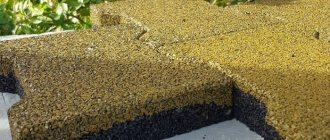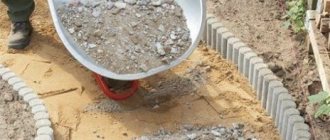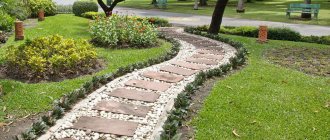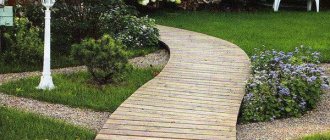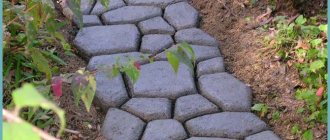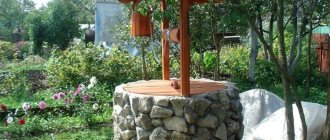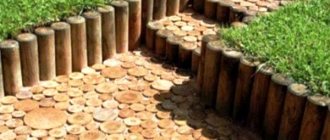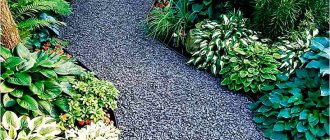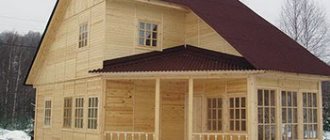What is a step track
Often, when choosing a style for their garden plot, people try to recreate the natural landscape. With this approach, it is important to maintain the line at which the garden will look well-groomed, and not abandoned and wild. Therefore, certain nuances are taken into account:
- selection of plants, their combinations;
- decoration of outbuildings;
- specifics of the site's relief;
- type of tracks.
It is worth paying attention to the step-by-step paths in the garden. This element of site decoration allows you to harmoniously combine the finishing material from which the object will be made with plants . There will be no stagnation of rain and melt water on such paths. Also, such paths are an economical option compared to solid paving analogues.
The path in the garden is the most common decorative element. It is important not only its aesthetic appearance, but also the correct location. After all, the ease of use of all corners of the garden depends on how well it fits into the space of the entire site.
Did you know? The production of paving slabs is inextricably linked with concrete.
The 25 cm thick concrete floor was first discovered in Yugoslavia in a hut on the banks of the Danube. The find dates back to approximately 5600 BC. e.
Materials for the construction of paths and paths.
Natural stone is a very decorative coating that can be used to bring many of the ideas of landscape architects to life. A huge selection of colors and textures is the main advantage of this material, because with its help you can create the style of a “wild” path or make a bright French path. This material is also a very durable, natural and environmentally friendly coating.
Wood is also an excellent material for a path, as it can add warmth and naturalness to an area, making every path part of the natural environment. Wooden garden paths can be made in the form of sections of round logs sunk into the ground, transverse crossbars, or made in the form of backfill with tree bark or sawdust. The disadvantage of this type of coating is its relative fragility.
Artificial materials (concrete, asphalt, brick, paving slabs) are excellent decorative materials that designers love for their versatility and ease of installation and maintenance. Using these materials, you can make both simple paths and complex paths with a pattern or bright colored areas. This material is also a relatively inexpensive coating. Bulk paths are a fairly simple and convenient coating that is relatively cheap to create.
Grass paths are a separate type of site covering, since they differ significantly in properties from other types and are quite demanding in terms of care. Covering the path with grass makes sense only for those portions of the paths on the site that are purely for walking and will not be used frequently for walking, since they are inconvenient for use in rainy weather.
The architects of our Landscape and Design workshop combine various materials on one site, thereby achieving the maximum decorative effect and making your road and path network unique.
Rules for laying step paths
In order for the path on the lawn to please the owners of the site with its appearance, it is necessary to approach its installation competently. First you need to think through the scheme.
When planning, you should adhere to certain rules:
- Take into account the terrain of the area . The path should fit harmoniously into the landscape with its curves.
- It is beneficial to emphasize the advantages of the garden or hide its shortcomings.
- Serve as a design technique to combine all elements of the landscape.
- The most attractive corners should be visible from the path .
- A closed track system is preferred . If possible, you should avoid having the main lawn covered with them.
- On modest-sized sites, perimeter trails are preferred .
- When constructing paths, it is necessary to avoid crossing them at an acute angle .
- Calculate the width of the object , which should fit harmoniously into the size of the garden (usually at least 0.7 m).
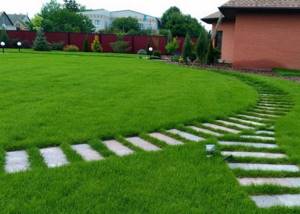
Most often, straight paths are found in city parks . But there are times when on a personal plot you need to create the shortest path to some structure. Winding ones are designed to visually enlarge the boundaries of the garden. Both types have both advantages and disadvantages. Therefore, in modern landscape design, a combination of strict geometric lines with winding ones is often used.
This type of garden design elements contributes, on the one hand, to dividing the territory of the site into separate zones, and on the other hand, it unites it into one whole. This is facilitated not so much by the competent arrangement of the paths themselves, but by the carefully selected material for their construction.
Also find out how to make paths in greenhouses yourself?
A walking path is as important an element of a lawn area as all buildings . Therefore, it is important to think about their arrangement along with the construction of the house itself and all outbuildings. It is best to draw up a detailed diagram, drawing on it all the objects (house, garden, gazebos, bathhouse, greenhouses, sheds, playground, pond), and then connect them all with straight or curved lines.
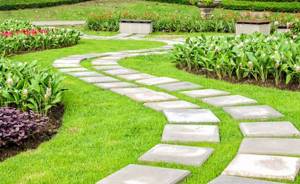
When planning a site, you should also take into account the materials from which not only the house and other buildings will be built, but also the communication routes between them. They must be compatible with each other.
If precipitation occurs frequently, it is necessary to consider a drainage system with drains along the sides of paths . This is done without fail, since water during freezing can ruin any material from which design objects are made. Also, trees with a strong root system should not grow near the coating, since their roots can easily deform structures even made of the strongest material.
Important! A step-by-step path can be created not only on land. If you turn it into a small bridge, it will decorate a shallow pond on the site. In this case, the elements should be cast from concrete.
Selection of material and tools for creation
To create a step-by-step path in the garden, you need a set of materials and tools, namely:
- stone or other material;
- crushed stone;
- sand;
- gravel;
- building level;
- sledgehammer;
- hammer;
- wheelbarrow;
- bucket;
- construction knife;
- shovel;
- measuring tape;
- twine.

The most durable material to use is hard rock (marble, granite). The advantage of using it for construction is that it is the stone that combines most effectively with the green carpet of the lawn. The downside is the high final cost of such structures, as well as technical difficulties in their construction.
Did you know? The heyday of cobblestone streets occurred during the Roman Empire. Road stone masonry was used, for example, in the construction of the road to Palantine Hill and in the construction of the pavements of the city of Pompeii.
Installing a brick path is more attractive in material terms . However, over time, the brick begins to crumble and the trail will lose its former beauty. Paths made of clinker paving stones are durable in use. This material can be easily repaired and is also environmentally friendly.
It is extremely rare that decorative elements made of concrete and asphalt are laid on personal plots, since this requires special equipment . However, the construction cost in this case is low. There is a material - decorative concrete. It is reliable and durable, can be painted, can be tiled, etc.
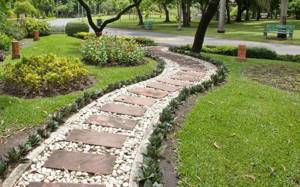
Laying out a path on the lawn
Arranging a walking path with your own hands does not require special skills or special knowledge. However, you will still have to pay attention to some aspects, because the functionality and ease of use of the trail directly depends on the implementation of these tasks.
Important! If the building material is large in size, for example, a large stone, then it should be sunk into the lawn using a building mixture, not sand.
The work plan is as follows:
- Outline all structures and proposed path layout options on the site diagram.
- Outline the boundaries of future paths on the ground using pegs, string and measuring tape.
- Direct laying of stone, slabs or other selected materials. To do this, at the future location of each fragment, it is necessary to outline its outline.
- Using a shovel, remove the layer of soil in the areas where each element of the path will be located.
- Compact the soil layer to prevent further settlement under the stone.
- Pour a layer of sand and gravel into the recesses that have formed.
- Place the selected material on the resulting sand cushion and deepen it.
- After paving is completed, fill the seams between stones or tiles with a layer of sand.
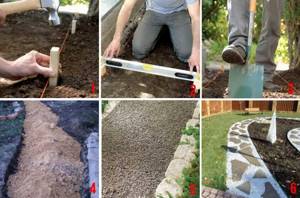
In the same way, arrange other decorative elements of the path to your liking.
Now you know how and from what to make a path on the lawn. Remember that you should take into account the degree of its load in the future and its purpose. With the right material chosen and the work done correctly, the path will be functional for many years.
Laying stones in steps
Around each stone, mark its outline using marking paint or a simple knife. The flagstone is removed to the side and the turf underneath is removed with a shovel to a depth of 5–10 cm.
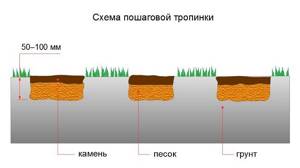
The dug bed is covered with sand and a watering can is poured out, and bulk material is added to the sagging areas. Place the stones in place, pressing them into the surface and placing them 10–15 mm above the plane of the lawn. If necessary, add sand with a trowel.
If a step-by-step path is being installed on a new site, it is recommended to lay the foundation over the entire area. To do this, in the marked area, the soil is cut to a depth of 20–25 cm and a drainage layer of 10 cm is arranged. A well-compacted sand cushion is placed on top and only then the area is paved with stone.
The gaps between the quartzite slabs are filled with soil, planted with grass, or materials at hand, such as pebbles and sawdust, are used.
Step-by-step paths are much more economical than continuous coverings, and making them yourself is much easier. As an option, it is possible to use a thin stone, but it should be laid on a cement mortar, otherwise the tiles will break under the weight of a person.
Materials for paths
Paths made of wooden elements look attractive, but in conditions of regularly watered areas they turn out to be impractical, because... quickly become infected with fungus and become damp. An alternative to natural wood is wood-look tiles that are not susceptible to mold and rot.
Paths made of natural stone have a long service life, but at the same time they are expensive. Therefore, often instead of natural stone, they use artificial stone, which has an even greater variety of textures and colors, but is much cheaper.
But perhaps the most popular material for paths on lawns is different types of paving stones and tiles. For an original design of paths in your country house, you can choose tiles of non-standard shapes and sizes, or combine the most common square and rectangular elements in the form of geometric shapes or patterns, combine parts of different colors, etc. These materials in the design of paths combine well with sand, crushed stone and pebble backfill, especially colored ones.
sidewalk tile
